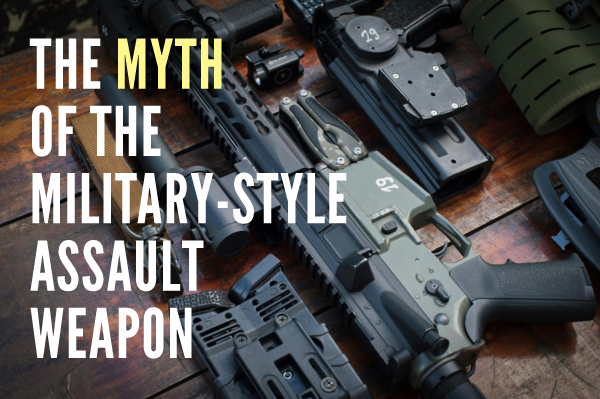
There are plenty of myths that revolve around the Second Amendment: that it’s only meant for the militia, or only for hunting, or that some weapons are just too dangerous. These are only a few of those myths. When we read the Constitution, along with just a tiny bit of research into the Bill of Rights, these myths should evaporate like the morning mist. In the case Bianchi v. Brown, it appears the Fourth Circuit believes the myths. However, some unorthodox procedures may show the court manipulated the process to get the desired outcome.
Assault Weapons Ban
Maryland, like some other states, have laws known as “assault weapons bans.” First, we have to define what Maryland calls an “assault weapon.”
The statute defines “assault weapon” as “(1) an assault long gun; (2) an assault pistol; or (3) a copycat weapon.” … The term “assault long gun,” in turn, encompasses more than forty-five enumerated long guns “or their copies, regardless of which company produced and manufactured” the firearm. …. These proscribed guns include an assortment of military-style rifles and shotguns capable of semiautomatic fire, such as the AK-47, almost all models of the AR-15, the SPAS-12, and the Barrett .50 caliber sniper rifle. … The term “assault pistol” encompasses more than fifteen enumerated firearms and their copies. These include the TEC-9 and semiautomatic variants of the MAC-10, MP5K, UZI, and other military-style submachine guns.
— Bianchi v. Brown
Maryland defines many different rifles, shotguns, and pistols as “assault weapons.” Many of these weapons are actually semi-automatic weapons, as opposed to the full-automatic many people think of as “assault” or “military style” weapons. Maryland also defines a “copycat” weapon as
a firearm that is not an assault long gun or assault pistol yet is covered by at least one of the following six categories:
(i) a semiautomatic centerfire rifle that can accept a detachable magazine and has any two of the following:
a folding stock;
a grenade launcher or flare launcher; or
a flash suppressor;
(ii) a semiautomatic centerfire rifle that has a fixed magazine with the capacity to accept more than 10 rounds;
(iii) a semiautomatic centerfire rifle that has an overall length of less than 29 inches;
(iv) a semiautomatic pistol with a fixed magazine that can accept more than 10 rounds;
(v) a semiautomatic shotgun that has a folding stock; or
(vi) a shotgun with a revolving cylinder.
— Bianchi v. Brown
What I find interesting are the banned features that have nothing to do with the lethality of the weapon. For example, how does a folding stock or flash suppressor make the weapon more lethal? The answer is that it doesn’t. Nevertheless, Maryland law prohibits any person in the state from selling, purchasing, receiving, transporting, transferring or possessing these “assault weapons.” A violator of Md. Code, Crim. Law § 4-303 faces up to three years of imprisonment. Maryland law enforcement officers are also authorized to seize and dispose of the weapons in violation of this law.
There are several constitutional issues with this Maryland law, not just regarding the Second Amendment. Chief among them is the confiscation of so-called “assault weapons.” Is it reasonable for law enforcement to seize property that was legally purchased? It’s one thing to seize an item that was purchased or even transported in violation of the law, but what about the weapons that were purchased, received, or transported before this law went into effect?
The right of the people to be secure in their persons, houses, papers, and effects, against unreasonable searches and seizures, shall not be violated.
— U.S. Constitution, Amendment IV
It also violates the Fourteenth Amendment:
nor shall any State deprive any person of life, liberty, or property, without due process of law;
— U.S. Constitution, Amendment XIV
Those who challenged the law did not claim it was a violation of the Fourth or Fourteenth Amendments, but of the Second.
Appellants are three Maryland residents who allege that they are legally eligible to possess and acquire firearms, three nonprofit gun rights organizations to which the residents belong, and a licensed firearms dealer based in Maryland. On November 13, 2020, appellants filed a complaint under 42 U.S.C. § 1983 in the U.S. District Court for the District of Maryland against the then-Attorney General of Maryland and other state law enforcement officials. Appellants contended that these officials’ enforcement of Maryland’s assault weapons regulations was unconstitutional under the Second Amendment’s right to keep and bear arms.
— Bianchi v. Brown
Bianchi and company agreed that what they were asking the court to do was contrary to the court’s previous opinion in Kolbe v. Hogan—a previous constitutional challenge to the very same Maryland statute, in which the court concluded that the assault weapons at issue were “not constitutionally protected arms.” Between the court’s decision in Kolbe and this case, however, the Supreme Court had decided New York State Rifle & Pistol Association v. Bruen.
In Bruen, the Court disavowed as “one step too many” the two-step framework that our court used in Kolbe and that other federal circuit courts had nearly universally employed to assess Second Amendment claims. . . . Because “the Second Amendment . . . codified a pre-existing right,” courts were not to engage in interest balancing to determine whether a challenged regulation was constitutionally permissible.
— Bianchi v. Brown
Shenanigans
Let’s start with the explanation of what happened from a footnote on page 87 of the decision.
This unorthodox procedural posture bears some explanation. After hearing the case in December 2022, the initial panel majority reached a decision and promptly circulated a draft opinion. Yet for more than a year, no dissent was circulated. The panel thus held the proposed opinion in accordance with our custom that majority and dissenting opinions be published together. A year later—as the proposed opinion sat idle—a different panel heard arguments in United States v. Price (No. 22-4609), which also involved interpreting and applying Bruen. The Price panel quickly circulated a unanimous opinion that reached a conclusion at odds with the Bianchi majority’s year-old proposed opinion. Facing two competing proposed published opinions, the court declined to let the earlier circulated opinion control. Rather, in January 2024, we “invoked the once-extraordinary mechanism of initial-en-banc review.” … (suggesting that majority opinions may be issued without awaiting dissenting opinions to prohibit those dissenting opinions from exercising a “pocket veto” to “deny or delay fairness and justice”).
— Bianchi v. Brown
So, after hearing the case in December, the court sat on it for more than a year. Why was no dissent circulated? Was one written, but not distributed? Did one of the panel vote against the decision but never write a dissent? I don’t know. However, it’s apparent that another panel had a unanimous decision different from the one the Bianchi panel had made. To make things worse, the full court decided to review the case even though the reviewing panel had not published its decision. Why did the court make this extraordinary move? Could it be that, as the court in United States v. Gibbs warned, that the dissent exercised a “pocket veto”? Did the dissent in Bianchi delay justice to get the outcome they wanted?
Second Amendment
The Second Amendment instructs, “A well regulated Militia, being necessary to the security of a free State, the right of the people to keep and bear Arms, shall not be infringed.” U.S. Const. amend. II. This single sentence provides us with a lofty command, but little concrete guidance. In the past two decades, the Supreme Court has stepped in to provide this guidance, offering a methodological framework by which to structure our inquiry.
— Bianchi v. Brown
Here I completely disagree with the court. The Second Amendment gives very concrete guidance: The right of the people to keep and bear arms shall not be infringed. It doesn’t get much more concrete than that. Of course, I’m pretty sure the court wants some wiggle room to get the outcome it wants.
Having elucidated our understanding of the Second Amendment’s text in its historical context, we turn to the Maryland regulations under challenge in the present case. Our analysis confirms that the covered weapons are not within the ambit of the “right to keep and bear arms” as codified within the plain text of the Second Amendment.
— Bianchi v. Brown
While the court may have “elucidated” their understanding of the Second Amendment, their understanding is not based in the law and their analysis is not based on the language of the Second Amendment.
The AR-15
Since the AR-15 is so often the target of these “assault weapons bans,” the court takes the time to look specifically at that weapon. Sadly, the court again gets its facts wrong.
The civilian versions of the AR-15 have not strayed far from the rifle’s military origin.
— Bianchi v. Brown
The AR-15 is not derived from military weapons; it’s actually the other way around. First developed in the 1950s for civilian use, the AR-15 rifle was named after its manufacturer, Armalite. The letters “AR” do not stand for “assault rifle” or “automatic rifle.”
Armalite sold the rifle’s design to another firearms manufacturer, Colt, in 1959. Four years later, the U.S. military selected Colt to manufacture a standard-issue model of the AR-15—dubbed the M-16—for soldiers in the Vietnam War.
The AR-15 continues to use the same internal piston firing system and the same ammunition as the M16 . . . . Its bullets leave the muzzle at a similar velocity of around 3000 feet per second, have a similar effective area target range of up to 875 yards, and deliver a similar amount of kinetic energy upon impact.
— Bianchi v. Brown
The court starts with pointing out that the AR-15 and M-16 use the same “firing system.” That merely means that both weapons fire, extract the spent casing, load a new round, and return to battery the same way. Specifically, there is a spring inside a tube (known as the buffer tube), that stops the bolt when it’s pushed back by the fired round, and pushes the bolt back into “battery,” or ready to fire. By the way, while the specifics may be different, this is how pretty much every semi-automatic weapon works. Either the recoil or gas from the fired round pushes a bolt or slide back into a spring, which then pushes it back into battery.
The court also makes the scary point that both the AR-15 and the M-16 have similar muzzle velocities. Of course the court fails to mention that more than three dozen rifle calibers have a muzzle velocity of 3,000 ft/min or more. In fact, the average “deer rifle” cartridge like a .308 or .30-06 has up to 50% more kinetic energy than the .223 used in the AR-15.
The court further points out that additional contemporary features of the AR-15 include a “pistol grip that enables fast reloading and accuracy during sustained firing.”
I cannot see why fast reloading or accuracy would be a bad thing, whether it’s for a shooting competition or defending yourself and your family.
Most versions of the AR-15, like the M16, use detachable 20-round or 30-round magazines . . . Both weapons are also compatible with up to 100-round magazines. … Other combat-functional features that the AR-15 and M16 share include a threaded barrel for the affixing of a flash suppressor, recoil compensator, or silencer; a barrel shroud to protect the shooter’s hands from excessive heat during sustained firing; and a rail integration system for the mounting of sights, scopes, slings, flashlights, lasers, foregrips, bipods, bayonets, and under-barrel grenade launchers or shotguns.
— Bianchi v. Brown
In short, the court appears to not like the AR-15 because it’s a very flexible and capable platform. Lost on the court is the fact that there are plenty of legitimate reasons to sustain fire. Shooting competitions or having to defend yourself against a gang of criminals attempting to enter your house are just a few.
The Decision
Based on all of this, how did the court find?
The Framers recognized they could not foresee all the dangers that novel weaponry would someday pose, or the circumstances that would invoke the basic power of government to protect the governed . . . we hold that the Maryland statute is plainly a constitutional enactment.
— Bianchi v. Brown
The Second Amendment was not drafted to limit the powers of the people so government could protect them. The Second Amendment was drafted to insure the American people could defend themselves, including defense against a government that went beyond its limited and enumerated powers.
Any arm and weapon of offense or armor for defense is protected by the Second Amendment. The members of this court violated their oaths of office.
Conclusion
Are there weapons too dangerous for the people to use? If there are, then they are too dangerous for people in government to use as well.
“The very atmosphere of firearms anywhere and everywhere restrains evil interference—they deserve a place of honor with all that’s good.” — George Washington
The purpose of the Second Amendment is not to protect hunting or shooting sports, but to insure that the people have the tools necessary to restrain evil interference in their lives.
[T]he advantage of being armed, which the Americans possess over the people of almost every other nation, the existence of subordinate governments, to which the people are attached, and by which the militia officers are appointed, forms a barrier against the enterprises of ambition, more insurmountable than any which a simple government of any form can admit of.
— James Madison, Federalist #46
The very fact that the American people are armed and can form militias attached to their states is a barrier to the enterprises of an ambitious government, even if the states and the people haven’t used them lately. These are a few of the quotes from our Founding Fathers about our right to keep and bear arms, but I think they are best summarized by Noah Webster:
Before a standing army can rule, the people must be disarmed; as they are in almost every kingdom of Europe. The supreme power in America cannot enforce unjust laws by the sword; because the whole body of the people are armed, and constitute a force superior to any bands of regular troops that can be, on any pretense, raised in the United States. A military force, at the command of Congress, can execute no laws, but such as the people perceive to be just and constitutional; for they will possess the power, and jealousy will instantly inspire the inclination, to resist the execution of a law which appears to them unjust and oppressive.
— Noah Webster
This court got it wrong, for many reasons. They made outrageous and erroneous claims about the weapons in question, they attempted to scare people into agreeing with their decision, and apparently denied the appellants justice by delaying the publication of their decision until after another panel gave them the answer they wanted. Worst of all, this court completely ignored the law and made one up for itself. Because of the court’s malfeasance, people in Maryland will be denied their rights protected by the Constitution. Some may even be arrested, jailed, and forever denied their rights as convicted felons, in large part because this court sought an outcome rather than applying the law. I only wish the members of this court could feel the shame they so richly deserve for this decision.
___
Photo, top, courtesy of Dan Galvani Sommavilla / Pexels












